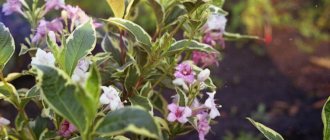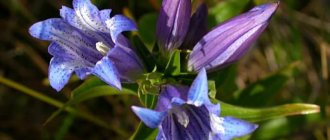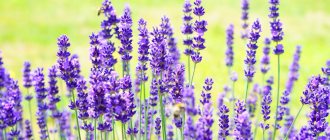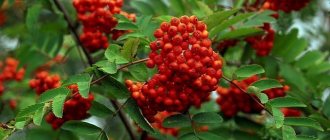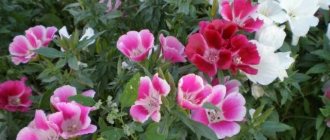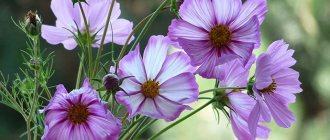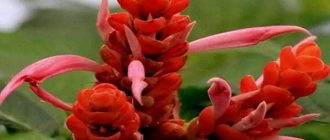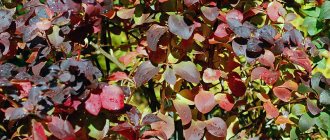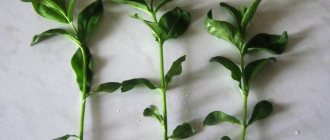Description
Hosta is a perennial decorative foliage plant. Its homeland is the Far East, Japan, China and the countries of Southeast Asia, where these beautiful bushes grow in natural conditions.
Previously, this plant and the genus as a whole were called Funkia, which was given in honor of the German botanist Heinrich Christian Funk, who lived in the 18th – 19th centuries.
In landscape design
Then both the perennial itself and the entire genus were officially renamed: this decision was made by the participants of the International Botanical Congress, held in 1905.
The plant received its new name in honor of Nikolaus Thomas Host, an Austrian doctor and botanist. Currently, the Khosta genus belongs to the Asparagus family, although previously it belonged to the Liliaceae family.
Hostas bloom in July-August. At this time, numerous funnel-shaped or bell-shaped flowers bloom on the bushes. They resemble small lilies, rise above the bushes on long peduncles and emit a delicate aroma. There are varieties with white, lilac and soft lilac shades of petals.

Plant flowers
1 The flowers look quite modest, and the main decoration of this plant is its luxurious foliage.
2 Leaves sitting on petioles form a basal rosette. Different varieties have different leaves in texture, shape and color. They can be narrowly lanceolate and broadly ovoid, plain and variegated, and have all sorts of shades of green and blue.
Hostas are the real long-livers among all herbaceous perennial plants; they live up to 25 years!
Neat bushes with leaves figuratively arranged in a peculiar “hairstyle” become more and more magnificent with age and retain their decorative effect for a very long time. They are used to create borders, and their leaves are also used in bouquets and flower arrangements.
How to order flowers for delivery?
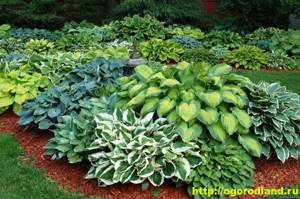
Now there are about 40 species of hosta. In general, the historical homeland of this plant is Asian countries. In Japan, hosta is a sacred plant . Hosta was originally brought from Asia to England, but there it did not deserve much love. It was only when hosta appeared in America that it gained enormous popularity.
One of the advantages of growing hosta is its unpretentiousness; it can withstand very low temperatures and is also drought-resistant . Its large, variedly colored leaves are a wonderful backdrop for flowering plants. But the hosta is used not only for the background; it also looks great as a single plant.
Hosta (functionia): types and varieties
Hosta funkia) is widely used in landscape design. This is due to the huge variety of species and varieties. As stated above, there are about 40 species, but there are more than 4 thousand varieties . Such a huge number of varieties have been developed from the main species:
- Plantain - glossy leaves of bright green color, the plant reaches 0.5 meters.
- Wavy - the edges of the leaves are wavy, the leaf color is not uniform (the middle is white with green strokes)
- Fortune - leaves of a pleasant green color with a creamy edge, the plant reaches a height of half a meter.
- Swollen - leaves have pointed tips.
- Curly - the leaves are dark green, wide, and have a white border.
- Hosta Siebold's leaves are monochromatic, but have clearly defined veining.
- Tall - the leaves are very large, dark green, glossy, the plant itself grows up to a meter in height.
Hosta varieties (functionia) can be divided into two categories : by plant size and by leaf color.
Based on the size of the variety, hostas are divided into 6 groups:
- Dwarf - below 10 centimeters
- Miniature - from 11 to 15 centimeters
- Small – from 16 to 25 centimeters
- Medium – from 30 to 50 centimeters
- Large - from 55 to 70 centimeters
- Gigantic - more than seventy centimeters.
There are 5 groups based on leaf color:
- Yellow – leaves have a yellow color
- Blue – leaf color is blue, gray
- Green – green leaves
- Hosta variegata - leaves have a variegated color, as well as varieties with a light border
- Mediovariegata - the leaves are light, but have a dark border.
Hosta (function): planting
Blue hosta
First you need to choose a place to plant. The best thing is a place protected from drafts and located in partial shade . But there is a certain nuance: the lighter the hosta leaf, the more light-loving it is. Blue-colored varieties grow well in full shade. The more shading there is, the slower the hosta will grow, but the leaf and the plant itself will be very large.
As for the soil, it should be rich in humus, slightly acidic or neutral. There must also be good drainage so that the water does not stagnate and the hosta roots do not rot. It is best to plant hosta in the spring, so the soil for planting it should be prepared in the fall.
How to prepare the soil for planting hosta? It's very easy to do. In the designated area, you need to mark a ten-centimeter layer of organic fertilizer (humus) and dig it up well. Next, you can apply a complex of mineral fertilizers and also dig well.
How to plant hosta (functions)?
When planting or replanting an adult plant, a planting hole is dug 1.5 times larger than the plant’s root system. At the bottom of the planting pit there must be drainage (porcelain balls, broken bricks, etc.). The plant must be planted so that only the roots are buried. Afterwards, pour well.
Hosta propagation (functions)
Hosta can be propagated in three ways: by dividing the bush, cuttings and seeds.
Amazingly beautiful host
The division of the bush is carried out in the spring. The resulting new plant (several new plants) is immediately planted in planting holes prepared in advance in the fall using the technology described above.
Cuttings are also carried out in the spring. There are several technologies for hosta cuttings. In order for the cutting to take root and you get a new healthy plant, you should: cut off a young and strong leaf as low as possible, place it at an angle of 25 degrees in a nutrient substrate. Already in August, a small rosette with a root system is formed. The young hosta is planted in a permanent place using the technology described above. However, it is better to cover such a seedling with covering material for the winter and open it in early spring.
Propagation by seeds is a much more complicated process than cuttings and dividing a bush.
How to propagate hosta (functionia) by seeds?
This method of propagation is chosen by the most avid gardeners or those who want to try something new. In general, growing hosta from seeds is not so difficult, but there are many nuances that must be followed, otherwise nothing will work.
The germination rate of hosta seeds is low - 70-80%, so they need pre-treatment with a growth stimulator. A purchased drug or aloe juice can serve as a growth stimulator. Experienced gardeners advise not only treating hosta seeds with a growth stimulant, but also stratifying them. The stratification method is the most common - the seeds are kept in the cold for a month.
Hosta by the pond
Another very important nuance is the sterility of the soil and planting container. It is best to buy soil in a specialized store, and treat the planting container with medical alcohol or a strong solution of potassium permanganate.
Place drainage at the bottom of the container, fill it with substrate and moisten it. Hosta seeds are placed on the surface of the substrate and sprinkled with soil (layer 5-7 millimeters). Next, the soil is moistened again, it is best to do this with a spray bottle. In order to retain moisture, the container is covered with plastic film or glass. At a temperature of 18-25 degrees, seedlings appear in two to three weeks. No need to remove the cover!
After the seeds have sprouted, they are placed in a bright place, but not in direct sunlight. Still immature plants need regular watering.
Immediately after the appearance of two true leaves, the seedlings dive. Picking a hosta is no different from picking peppers or eggplants. After picking, the plants can be hardened off by removing the covers, but not for long, just for a few hours.
Once the plants get stronger, 8-10 true leaves are formed; they can be planted in open ground in a permanent place.
In addition to the fact that there are many nuances in growing hostas from seeds , there is one big drawback - hostas grown from seeds often lose their varietal characteristics. Gardeners often wonder why, after sowing the seeds of a hosta, which has green leaves with a border, hostas with monochromatic dark green leaves grow.
How to care for hosta (functionia)?
In order for the hosta to develop normally, the soil must always be moist, but stagnation of moisture is not allowed. As for fertilizing, feed the hosta once every three to four years. But while the hosta is young, it can be watered once every two weeks with complex organic fertilizer, but you should not get carried away with mineral fertilizers.
Many gardeners want their hosta bushes to look neat throughout the season. In order to achieve this, young flower stalks should be removed, since after flowering the hosta “falls apart” and loses its shape.
Hosta (function): diseases and pests
Diseases very rarely affect the hosta . However, gray rot may occur , affecting the leaves, and sclerotinia, affecting the root collar . There are a huge number of drugs available to combat these diseases.
Hosta is very fond of slugs, stem nematodes and caterpillars . To save your plant from complete destruction, and the above insects can destroy the plant “at the root,” you need to regularly inspect the hosta, and if pests are detected, treat it with specialized preparations.
How to prepare a hosta (function) for winter?
No special preparation is required. In August, stop feeding if any was carried out. Autumn, if the plant is young, it can be covered.
Hosta (funkia) is a wonderful, unpretentious plant that will decorate any area with its luxurious foliage . It looks great near a pond, looks very natural and conveys this naturalness to the pond and the plants surrounding it.
Excellent(3)Poor(1)
Varieties

Hostas were brought to Europe from Japan in the 18th-19th centuries, and since then they have been cultivated. Based on height (excluding peduncles), these decorative perennials are divided into six groups.
However, there are no strict international standards for assigning a particular variety to a particular group. They may vary from country to country and even from supplier to supplier.
On average, all hosts are divided into:
- miniature (reach a height of just over 10 cm)
- dwarf (10-15 cm)
- short (15-35 cm)
- medium height (35-55 cm)
- tall (55-75 cm)
- giant (75-150 cm)
The Khosta genus has more than two dozen species. Moreover, some of them exist only in culture and are not found in natural growing conditions.
The most common and popular types are:
Wavy Hosta
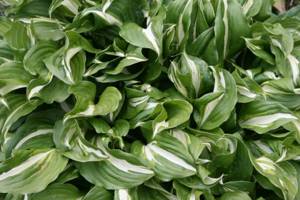
Wavy hosta A plant with leaves up to 20 cm long, elongated in shape and wavy edges.
In the color of the leaves, white areas alternate with green, and the flower petals are painted in a light purple hue.
Hosta Siebold
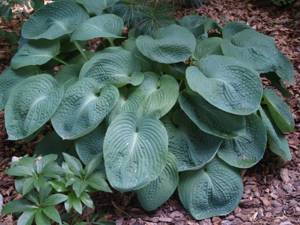
Hosta Siebolda A plant with dense, wide leaves up to 30 cm long, covered with a bluish waxy coating. The inflorescences are short and dense, the flowers are pale lilac or light purple in color. In the sun, the leaves of this species lose their bluish tint and become green.
This species is named after Philipp Franz von Siebold, a German naturalist and plant collector. He lived for some time in Japan in the 19th century and studied its flora and fauna. In addition to hosta, several dozen other Japanese plants bear the name Siebold.
Hosta lanceolifolia
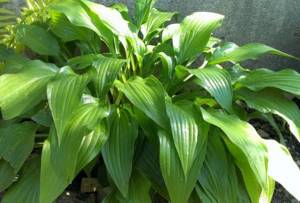
Hosta lanceolifolia The plant is native to Northeast China and southern Primorye.
The elongated lanceolate leaves are up to 25 cm long and form a compact bush, and numerous purple flowers bloom on peduncles up to 100 cm high in July-August. The bushes grow quickly.
Plantain hosta
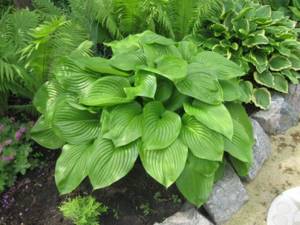
Plantain hosta The plant is native to Japan and China. Rounded leaves up to 40 cm long, painted bright green, form a large “cushion” that rises above the flower bed.
In August, flower stalks up to 100 cm tall with tubular flowers appear.
Hosta Fortune
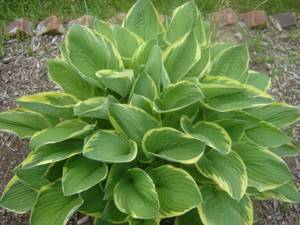
Hosta Fortune is in many ways similar to Hosta Siebold, but is smaller in size and has less waxy coating on the leaves. This species includes varieties that differ in color and size of leaves, shade of flowers and height of peduncles. Garden forms of this hosta are quite unpretentious and can grow only in temperate latitudes.
The species is named after the British botanist Robert Fortune. In the middle of the 19th century, he made several long trips to China, Japan and Taiwan, collecting unstudied and unknown plants in Europe.
Hosta white-edged
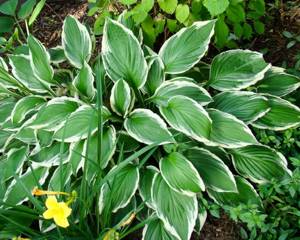
Hosta white-edged Forms a dense rosette of leaves and blooms in July-August. The bushes are small and can grow well in a container.
There are a large number of varieties of this species with green, yellow-green, dark green and blue-green crinkled leaves with a thin white border along the edge.
Hosta straightifolia
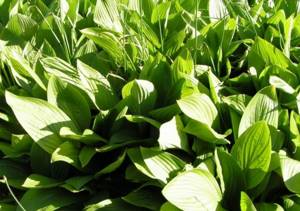
Hosta erectifolia A powerful plant with almost vertically growing leaves on long petioles. It grows wild in Japan, Sakhalin and the Kuril Islands.
In the Land of the Rising Sun, this plant is considered edible and even medicinal. It is used in many Japanese traditional medicine recipes.
Hosta swollen
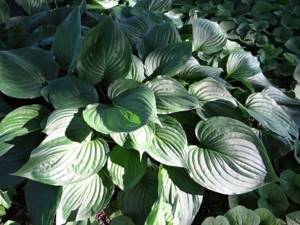
Hosta swollen Plant with wide heart-shaped leaves. Forms a powerful bush, reaching 80 cm in both height and width. Lilac flowers bloom on long (120 cm) peduncles in July-August.
This species has many varieties with a wide variety of leaf and flower colors.
Hosta. Varieties and types
In the world of floriculture, hosta species are divided into six groups, depending on the height of the plant:
- Dwarf - bushes only 10 cm high, with leaves in the shape of mouse ears of aquamarine color.
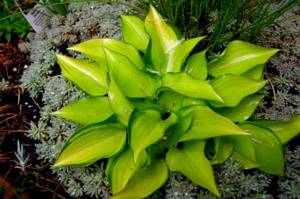
- Miniature - form bushes up to 15 centimeters high, leaves with a mix of yellow, blue and green colors.
- Small - from 16 to 25 centimeters high, have emerald leaves with a yellow or white stripe, or menthol-colored leaf blades.
- Medium - 30-50 centimeter bushes of dark green leaves with a whitish central part; in some varieties the leaves have a cream-colored edge; there are varieties with white leaves.
- Large ones - stretch from 55 to 70 cm in height, the leaves are menthol with an olive edge, or corrugated, rounded with a golden center, a wide greenish edge and pistachio-colored streaks.
- Giant - reach 70 centimeters in height, have menthol leaves with a wide golden border.
The main species grown by gardeners:
- Hosta Curly. The leaves are dark green with a snow-white edge. The bush stretches up to 60 cm.
- Hosta Tall. Belongs to the species of giants. Grows up to 90 cm in length. Its large, shiny ones are painted a rich green color.
- Hosta Wavy. Stretches up to 75 cm. Long elongated leaves, wavy along the edges, green with white stripes. Blooms with purple bells.
- Hosta Siebold. The 30-centimeter bush consists of wide leaves covered with a smoky coating that disappears in bright sunlight. Blooms with soft purple buds.
- Hosta Fortune. The bush reaches a height of 50 centimeters. Has an external resemblance to Siebold's hosta. This species includes varieties that vary in shape and size of leaves, as well as flower color.
- Hosta swollen. A large bush can reach a height of 50 to 80 cm. The leaves are spreading and heart-shaped. By mid-summer it produces flower stalks 120cm long with a varied range of colors, depending on the variety.
- Hosta plantain. A bush of rounded leaves (up to 40 cm in length) reaches a height of about 50 centimeters. At the end of summer, meter-long flower stalks with numerous purple flowers stretch out.

- Hosta lanceolifolia. Fast-growing bushes can reach 25 cm in height. Funkia lanceolifolia is so named because of the lanceolate shape of the leaves.
- Hosta White-edged. A compact rosette of corrugated leaves blooms in midsummer. A huge number of varieties of this species differ in the range of colors from olive to menthol. But they all have a white border around the edge.
At the moment, more than 600 varieties of funkia are known. The most popular of them:
- Thunderbolt A fairly large rosette of dense menthol foliage and stripes that change color from white to yellow during the summer.
- First Frost. One of the most popular varieties. The 35 centimeter bush grows up to 90 cm wide. The foliage changes color from smoky blue to emerald during the summer.
- Sum and Substance . Belongs to giant varieties (80 cm in height and 1 m in diameter). The owner of large textured leaves of olive color. This variety is not susceptible to attacks by slugs, unlike its relatives. Looks great next to coniferous plants.
- Captain's Adventure. The compact bush is assembled from oval leaves with an original texture. It is distinguished by a wide cream border separated by a dark green stripe from the core. Blooms with small lavender buds.
- Lakeside Dragonfly. The small rosette grows in height and width up to 30cm. Menthol foliage with cream edges. It blooms from mid-summer to early autumn with purple flowers.
- T-Rex. The giant hosta reaches 15 meters in height and has gorgeous smoky-greenish leaves. The plate has an unusual corrugated texture. It blooms for a long time with milky white inflorescences.
- So Sweet. Very aromatic variety. The low bush is framed by wedge-shaped green leaves with a white stripe along the edge. This function feels great in the sun.
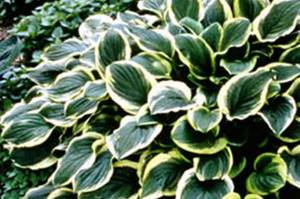
- Blue Ivory. A chameleon variety that changes the color of the leaf blade during the season from smoky blue to light azure with whitish edges. The bush grows up to a meter in diameter and reaches a height of 50 cm.
- Liberty. A very original variety. Dense heart-shaped foliage with a golden border forms a tall bush (up to 0.8 m). It does not like shade; with a lack of sunlight, the foliage turns green, losing its originality.
- Blue Cadet. It is a small bush of turquoise dense foliage with lavender flowers.
- Little White Lines . The miniature variegated funkia feels great both in the flowerbed and in containers.
- Pandora's Box. Tiny hosta with beautiful textured rounded leaves. The color of the leaf blades is very original - it’s as if milk was spilled on the emerald leaves.
Function of reproduction
The plant reproduces in three ways:
- Division of rhizomes. It is the main method of hosta reproduction. Adult bushes are divided in late spring or early autumn. This should not be done too often; it may adversely affect the decorative appearance and growth of the flower. Depending on the variety, division is carried out every 3-5 years.
- Cuttings. This method of reproduction occurs at the very beginning of summer. Young shoots with a “heel” are used as cuttings and they are rooted in highly moist soil.
- Growing seeds. Perhaps the most labor-intensive method of propagating hostas. The point is also that the seedlings are very slow in growth and will be able to become a full-fledged decoration of the flower garden no earlier than in 4 years. To speed up the germination process, you should treat the seeds with growth stimulants (place them in Zircon, Epin or Kornevin for half an hour, aloe juice is also suitable) or place them in the refrigerator for a month.
Seeds are sown in April-May. The container for planting is pre-disinfected with a solution of manganese or medical alcohol. Drainage is poured into the bottom, then soil, which should be watered thoroughly. The seeds are placed on the surface of the soil and lightly sprinkled with substrate, after which the soil should be slightly crushed and a greenhouse effect should be created using a transparent plastic film.
Attention! Do not take soil for sowing seeds from your garden plot; it may contain fungi and infectious agents. It is better to purchase the substrate in the store. It should be peat-based, not acidic, enriched with minerals.
Caring for seedlings is easy. You need to place the pot with the seeds in partial shade, ensure a temperature of 20-25 degrees, organize moderate watering and collect accumulated condensate from the film. With proper care, the first shoots will appear on day 14-20, then they need to be provided with more light.
Picking into individual containers is done when the first 2 leaves appear on the sprouts. The seedlings are transplanted into pots filled ¾ with soil mixture and ¼ with sand. Young hosta shoots prefer exclusively bottom watering. After picking, the hardening process begins. To begin with, the covering material is removed for several hours, after a week it is removed completely and the functions are taken outside, but only if the air temperature does not drop below 18 degrees.
Varieties
Today, about 600 varieties of hosta are known. Every year dozens of new varieties are registered, including many amazing and truly luxurious ones. We will introduce you to the most beautiful, popular and unusual varieties that can take their rightful place in your garden.
Blue Angel
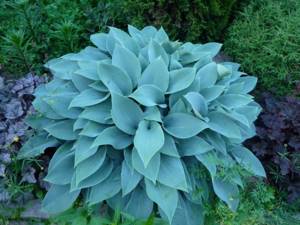
Blue Angel A giant variety with graceful blue-green leaves cascading down in a beautiful cascade. The height of the bushes is 100-120 cm. The flowers are lavender in color.
The variety is shade-tolerant and can only withstand morning sun.
Albomarginata
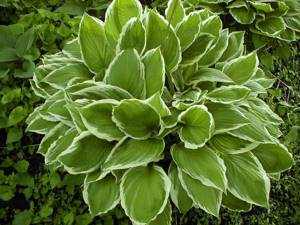
Blue Angel A charming medium-sized variety with a dense rosette of leaves. The bushes are spreading, up to 60 cm high and wide. The leaves are green, with a thin white edging along the edge, slightly corrugated.
Big Daddy
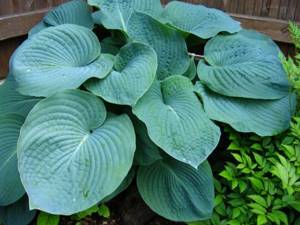
Blue Angel (Blue Angel) A powerful plant of large size with leaves of expressive texture. This is one of the best varieties among the blue foliage varieties. The leaves have a diameter of up to 30 cm.
White flowers bloom on meter-long peduncles.
Wolverine (Wolverine)
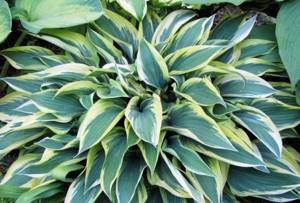
Wolverine (Wolverine) Wolverine, whose spreading bushes grow up to 35 cm in height and up to 80 cm in width. The leaves of this variety are narrow, lanceolate, blue-green, with a yellowish edging along the edge.
The foliage acquires the greatest contrast in the second year of growth.
Red October
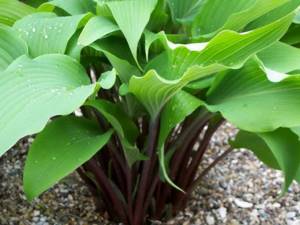
Red October (Red October) A medium-sized hybrid variety with showy red petioles that contrast with green foliage. The bushes grow up to 40 cm in height and 60 cm in diameter.
Purple flowers bloom in August.
Broadway
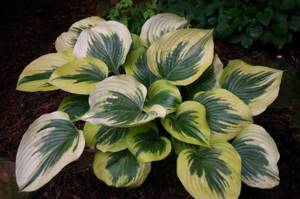
Broadway (Broadway) A beautiful variety with dense embossed heart-shaped leaves. The color of the leaves is bluish-green, along the edge there is a wide, uneven border of yellowish-cream color.
The bushes grow up to 55-60 cm in height. The flowers have a lavender hue.
White Feather
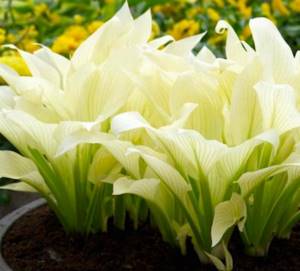
White Feather One of the most spectacular hybrid varieties. This beautiful plant forms a compact bush (up to 35-50 cm).
Graceful creamy-white leaves with light green veins, really looking like feathers, sit on green petioles.
Variety Paul's Glory (Glory of Paul)
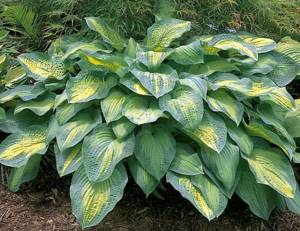
Variety Paul's Glory (Glory of Paul) In 1999, he received the honorary title of “Hosta of the Year,” which is awarded annually by the American Hosta Growers Association. The leaves of this variety are very decorative. Their color alternates between yellow and blue-green shades, as if applied with an artist’s brush.
However, the color may change throughout the season. Starting from the age of three, the leaves acquire an interesting “crinkled” texture. The bushes are spreading: an adult plant reaches 60-70 cm in height and up to 90 cm in diameter.
Praying Hands
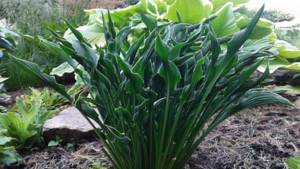
Praying Hands An original variety with narrow leaves that grow almost vertically. At first glance at this hosta, it immediately becomes clear why it received its unusual name.
The leaves of this variety are dark green in color and have wavy edges. The medium-sized bush reaches a height of up to 40 cm.
Gold Standard
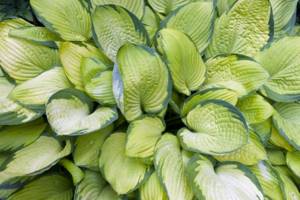
Gold Standard Forms spreading dome-shaped bushes up to 60-70 cm high and 120 cm wide.
The heart-shaped leaves are yellow-green or yellow with a contrasting dark green edge.
Gypsy Rose (Gypsy Rose)
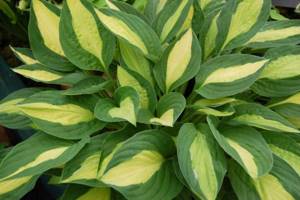
Gypsy Rose An attractive plant with expressive leaves that have distinct light and dark green color zones.
The bushes of this spectacular variety reach 40 cm in height and up to 75 cm in width.
Guacemole (Guacamole)
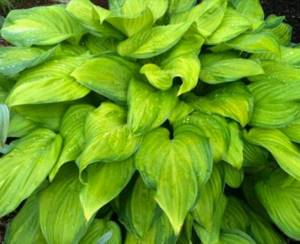
Guacemole (Guacamole) An excellent option for a shady garden. The shiny, heart-shaped leaves of this variety are apple green with a dark green edge. The bushes grow up to 60 cm in height and have a diameter of 70-100 cm.
In 2002, this variety was named “Hosta of the Year” by the American Hosta Growers Association.
Liberty

Liberty (Freedom) A beautiful variety that retains its decorative effect throughout the growing season. Dense leaves with spectacular contrasting colors are among the most memorable.
In late autumn, when the foliage of other varieties has already died off, Liberty will continue to please the eye in a dormant garden. With age, the bushes of this variety quickly grow and acquire a beautiful shape, and the border on the leaves becomes wider.
Moerheim
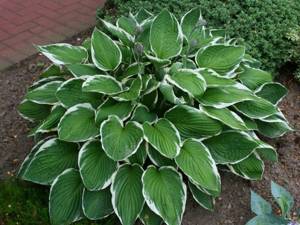
Moerheim Tall, fast-growing variety. The bushes reach both height and width up to 60 cm.
The heart-shaped leaves are 15-20 cm long, dark green in color and have a thin white border along the edge of the leaf blade.
Patriot
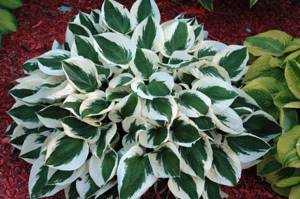
Patriot (Patriot) A popular variety in ornamental gardening. Small compact bushes reach 40 cm in height and grow up to 70 cm in width.
The dark green leaves are outlined with a contrasting whitish-cream wide border. This variety blooms in the second half of summer with lavender flowers.
Purple Heart variety
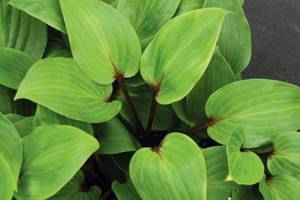
Variety Purple Heart (Purple Heart) Refers to the red-petioled varieties. Breeders have not yet developed varieties with red or purple leaves, but the first step in this direction has already been taken.
The red-brown petioles of this variety contrast with the bright green hue of the foliage, and the flower stalks have the same rich color. Pale lilac flowers, of which there are up to 30 on each peduncle, have a purple tint at the base.
Risky Business
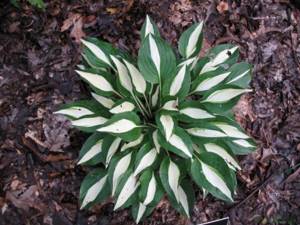
Risky Business A variety with dense dark green leaves, along the center of which there are clearly defined creamy white stripes. The bushes grow up to 40 cm in height and up to 60 cm in width.
It blooms in July with lavender flowers on long stalks.
Sharmon
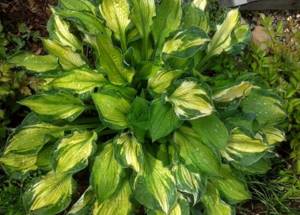
Sharmon A very spectacular variety that can decorate any shady garden. The bushes grow up to 55 cm in height and up to 80 cm in width.
The color of the leaves combines a bright green tint with light greenery and yellowish-cream areas and stripes, giving the plant an unusual decorative appearance.
Stiletto (Stiletto)
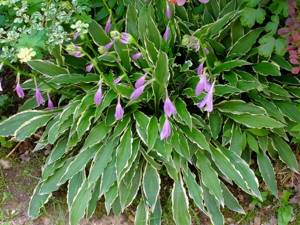
Stiletto (Stiletto) An original variety with long narrow leaves and low bushes growing up to 25-35 cm. Slightly wavy leaves are green and have a thin white border along the edge.
This variety blooms with small bell-shaped flowers of a light lilac hue.
Undulata Mediovariegata
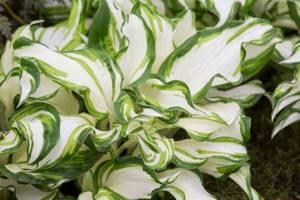
Undulata Mediovariegata A compact variety that belongs to the wavy hosta variety. Beautifully curled leaves attract attention with wavy edges and contrasting creamy-green colors.
Bushes up to 40 cm high look impressive in flower beds and landscape compositions.
Curly Fries
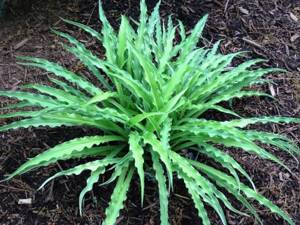
Curly Fries An original low-growing variety. The leaves with wavy edges are very narrow and long, growing quickly, forming a kind of “mow.” The bushes reach 25-30 cm in height.
Light green leaves gradually change their color to yellow-green.
Description of plantain hosta
Hosta plantain is sometimes called plantain lily. This is a perennial flowering shrub with relatively high peduncles (up to 45-50 cm in height). The inflorescences are short and dense, flowers appear in late July - early August. The petals are painted white and cream colors. The length of the flowers is 10-13 cm. Flowering in the climatic conditions of the middle zone can be irregular, but in the southern regions it is stable.
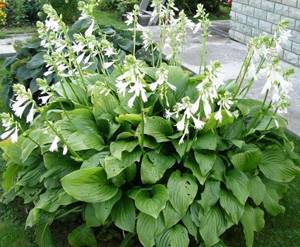
The tubular flowers of Hosta plantain exude a noticeable, pleasant aroma.
The bush is quite compact, up to 50-60 cm in diameter. The leaves are large (up to 28 cm long, 20 cm wide), oval, heart-shaped. They are distinguished by a shiny, slightly wrinkled surface with 7 pairs of veins. The edges are almost straight, slightly wavy. Hosta plantain is a sun-loving variety, and it also tolerates light shading (several hours a day). With proper care, the bush grows quickly, but still remains compact.
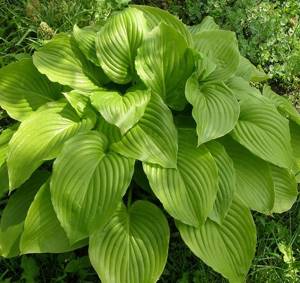
Hosta plantain is distinguished not only by its beautiful flowers, but also by its decorative leaves.
The winter hardiness of green hosta plantain is not too high - it may not withstand extreme frosts below -25 degrees (zone 4). Therefore, the recommended growing regions include the following:
- Moscow region and middle zone;
- Volga region;
- Chernozem region;
- South of Russia.
Important! It is almost impossible to grow hosta plantain in Siberia and the Urals. Even if you protect it from frost for the winter, it may not have time to bloom due to the short summer.
Varieties of plantain hosta
In nature, the plantain host Hosta Plantaginea grows in Japan and Eastern China. And under cultural conditions, 2 varieties are cultivated - Aphrodite and Grandiflora.
Grandiflora
Hosta plantain Grandiflora is often used for carpet plantings - both in compositions with other plants and in solitary (separate) plantings. It features beautiful foliage and tall peduncles. Looks appropriate in rock gardens and next to small bodies of water.
This type of plantain hosta has beautiful bright green foliage with a glossy surface.
Aphrodite
Hosta plantain Aphrodite is a large bush, peduncles grow up to 50 cm in height. At the same time, the flowers are also large, pure white, double, and give a strong aroma.
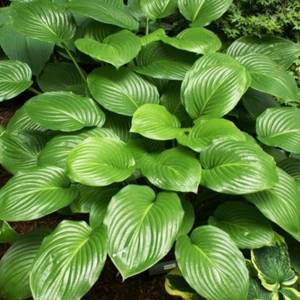
This plantain hosta variety grows quickly and prefers light shade rather than full sun.
Application in landscape design
Plantain hosta looks good:
- in solitary, carpet plantings (its lush foliage completely covers the soil and forms a homogeneous landscape);
- in mixborders with other colors;
- in rock gardens;
- on open lawns;
- near bodies of water.
The bush goes well with the following plants:
- marsh iris;
- lungwort;
- lavender;
- lily;
- jasmine;
- undergrowth;
- marigold;
- forget-me-not;
- astilbe and others.
Important! Hosta plantain goes well with almost all plants. But it is better not to plant it in the dense shade of trees and shrubs (for decorative reasons).
Reproduction
It reproduces in several ways:
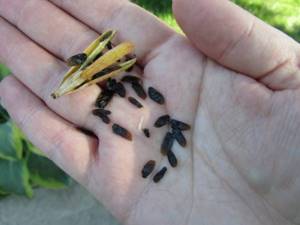
Hosta seeds
1 Seeds . Seeds should be sown in pots in spring or immediately in open ground in early June. With this method of propagation, seedlings develop very slowly and achieve a decorative appearance only in the fourth year.
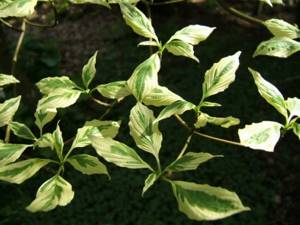
Reproduction by cuttings
2 Cuttings . This method is used from May to June. Young shoots with a “heel” are taken as cuttings and rooted in conditions of high humidity.
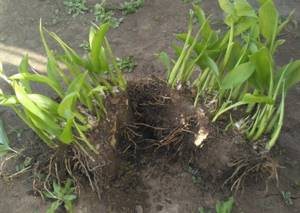
Rhizome division
3 Division of rhizomes . This is the main method of reproduction. The division of overgrown bushes is carried out in the spring (April-May) or autumn (August-September). You should not divide too often - this will slow down the development of the bushes and reduce their decorative effect.
Hosta propagation
Happens in three ways:
Dividing the bush
In the spring, using a sharp knife, divide the bush into small parts - planting material. The cut areas are sprinkled with crushed charcoal. A root layer with at least three rosettes will take root.
Planting takes place according to the general rules for hostas. In three to four years, a full-fledged shrub will grow.
Seeds
70% of seeds will not sprout without additional stimulation. This process is long at home. Does not guarantee success, unlike laboratory tests.
Hosta seeds “Sharmon” and “Revolution” are available for sale, which are suitable for growing on the site. Only in the second year after germination do leaves form. Growth is slow.
Disadvantage of the method: low percentage of obtaining exclusive variegated color forms. Usually these will be typical green leaves - the law of character splitting.
To preserve the maternal fund, the use of this method of reproduction is not effective.
Cuttings
To do this, shoots with young small leaves - with a “heel” - are cut off. For rooting, plant immediately in the ground. Cut the leaves in half. Provide shade and watering. The first three days are adaptation, the plant is lethargic. Then the tone of the leaves is restored.
In greenhouse conditions, the vegetative method is widespread - invitro. Allows hundreds of thousands of new shoots to grow from one bud of the mother plant. The main advantage of this method is the preservation of varietal purity of the species.
Landing
Hosta is planted in open ground in early spring or autumn. In the spring - before the leaves bloom, in the fall - after flowering, but with the expectation that the plants have time to take root before the cold weather and can winter well.
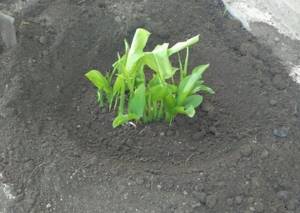
Planting a plant in spring
It can grow in one place for over two decades, and its bushes tend to grow. This must be taken into account when planting plants in the garden. The distance between bushes should be from 30 to 60 cm, depending on the type and variety of plant. If the specimens belong to giant varieties, the distance between such plants must be increased to 80-100 cm.
The planting hole should be prepared with sufficient width, since the root system of the hosta grows in breadth. You need to add rotted manure, peat, a small amount of sand to the hole and mix everything. Growth buds should be located at soil level. After planting, the plant is watered and mulched.
Caring for hosta in the open ground
The rules boil down to maintaining a balance of light, regular feeding and humidity. By following these rules, after a couple of years, a garden city will appear on the dacha plot.
watering
When watering, do not direct the flow of water to the green part of the plant. The root areas located under the leaves need constant moisture.
The frequency of water procedures is 2 times a week. In the morning or evening after 19:00.
fertilizing and fertilizing
It is rational to carry out after rain.
The attractive appearance of the shrub will be ensured by fertilizing three times a season: during active growth, flowering and after it.
Nitrogen-phosphorus and potassium-containing complexes are used as fertilizers. But the hosta prefers organic chemicals - composts and humus. These beneficial substances are added to the soil in the fall. Although you can add mullein solution (1:2) in June.
loosening the soil
Moderate and careful starts in April. This is necessary to enrich it with oxygen and enhance its biological activity.
pruning
Needs hygienic pruning. That is, in the removal of dead leaves and flower stalks. Old parts of the bush must be periodically cut out. In order not to disturb the compositional ensemble of the plant frame.
In autumn, after dropping some of the foliage, remove the remains.
replanting hostas in the fall
If there is a need for transplantation in the autumn, the procedure is performed in October. Only healthy plants are taken for planting. Don’t forget, it needs strength for rooting and immunity for overwintering. The root of the seedling should be smooth, at least 10 cm long. When digging into the hole, make sure that all the buds remain above the ground. Mulch the root areas with dry leaves or grass. In spring, the mulch should be removed.
You cannot plant a hosta in a place where another one grew. It won't take root.
preparing flowers for winter
Frost resistance of a plant does not mean the absence of measures to prepare for wintering. Preparation begins in August - stopping feeding.
Before frost, remove all leaves from the bush. The cut areas at the root are sprayed with fungicide. The rhizome is mulched. Cover the top with spruce branches.
You cannot use film or roofing felt. And materials that do not allow air to pass through.
Growing conditions
Hosta is a shade-tolerant and undemanding plant. These perennials prefer shady places, can tolerate irregular watering, withstand frost well and do not have high maintenance requirements. However, there are varieties that can grow in sunny areas - these include mainly varieties with yellow leaves.
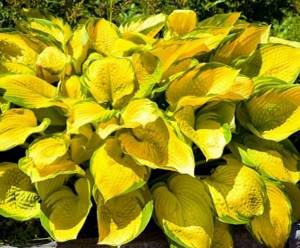
Some varieties grow well in sunny areas
It is undemanding to soils, but loose, rich, slightly acidic soil, such as acidic loams, suits them better than others. The soil should be moderately moistened, but excessive dampness cannot be tolerated. The plants are frost-resistant, but in cold regions it is recommended to mulch or cover the bushes with insulating materials for the winter.
The peculiarity of the plant is that the roots are close to the soil surface. This is why plants can suffer from frost in winter. Freezing occurs, as a rule, due to excessive humidity and soaking. Plants that are six years old and older are more susceptible to this than others.
Shallow roots can also cause them to overheat during the hot summer months. For this reason, it is better to choose a shady or semi-shaded area for plants. As for the southern regions, in these areas hosta can be successfully grown exclusively in the shade.
Rules of care
For an undemanding perennial crop, minimal care is provided, including watering, fertilizing and pruning. When grown in regions with cold winters, additional shelter is required.
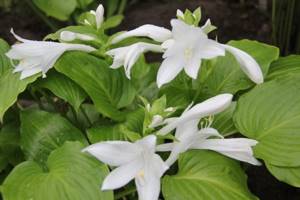
Hosta plantain photo description
Watering
Depending on weather conditions, the perennial is watered as the soil dries. Only newly planted bushes are given water twice a day for the first week, avoiding getting it on the foliage.
Feeding
The fertilizers added to the hole at the planting stage are enough for the hosta to last for the next two growing seasons. Next, the crop is fed once every three years:
- in the spring, liquid mineral fertilizers with a high nitrogen content are applied to intensively increase the vegetative mass;
- In autumn, the proportion of nitrogen-containing complexes is reduced, replacing them with potassium and phosphorus, which improve the general condition of the plant before cold weather and increase frost resistance.
Trimming
The hosta bush does not need to be formed. Only damaged leaves and shoots, as well as dried flower stalks, should be pruned.
Pre-winter preparation
The flower crop has good frost resistance, but when planted in unfavorable climate regions, winter insulation is required. This is caused by the superficial location of the root system.
The biggest problem when growing hosta is winter soaking and subsequent freezing of the main growing point. Plants over six years old are at risk.
To cover the roots, mulch made from coniferous spruce branches or a peat mixture, laid out in a layer of 5 cm, is suitable. You can replace the mulch with a covering material - agrofibre or polyethylene.
Garden care
You can often come across the following expression: hosta is a plant for the lazy. Growing these ornamental perennials is not particularly difficult; you just need to provide them with comfortable conditions for good growth and development.
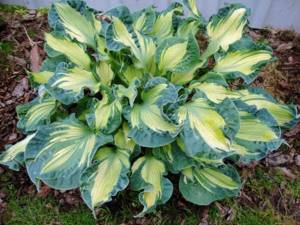
Hosta is an unpretentious plant
Responsive to fertilizer application. These perennials only require watering during the dry summer months when there is no rain. It is imperative to protect plants from snails and weed out weeds.
Diseases and pests
With proper agricultural technology, hostas are quite resistant to diseases. Dangerous pests include caterpillars and slugs, which eat leaves and reduce the decorativeness of bushes.
In this case, an effective method would be to mulch the root rosette with sawdust and ash. If a large number of insects attack, you can treat the bushes with an insecticide.
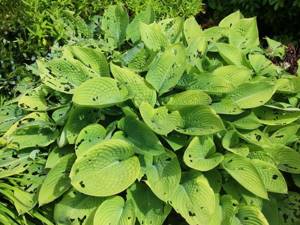
Leaves affected by the disease
Of the diseases, the most insidious is the host virus X or HVX (Hosta Virus X) - a specific disease discovered in 1996. It can proceed in a latent form for a long time, after which the plant begins to die: the leaves become deformed, become stained and die. Currently, scientists have not been able to find an effective cure for this disease.
The only thing the owner of a garden plot can do is to remove and burn the diseased bush when the first signs of the disease are detected, before the virus spreads to healthy neighboring plants. You should periodically check the bushes growing in the garden and carefully examine new specimens before purchasing them.
In landscape design
Plants are highly valued for their shade tolerance and decorative properties. Hostas are widely used in landscape design and home gardening. Large specimens look great in single plantings, miniature hostas can decorate an alpine hill or ridge, medium-sized plants look colorful in landscape compositions.
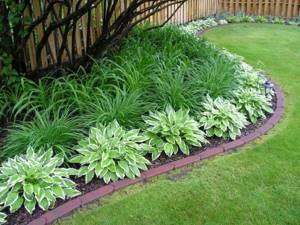
Flowerbed decoration
Hostas are great for flower beds and borders. Against the backdrop of paths, well-groomed lawns and ground cover “rugs”, their lush bushes can fully demonstrate their decorative properties.
Hostas are picturesquely combined with low-growing coniferous perennials, astilbes, lupins, daylilies, ferns, hellebores and other flowering and decorative foliage plants.
